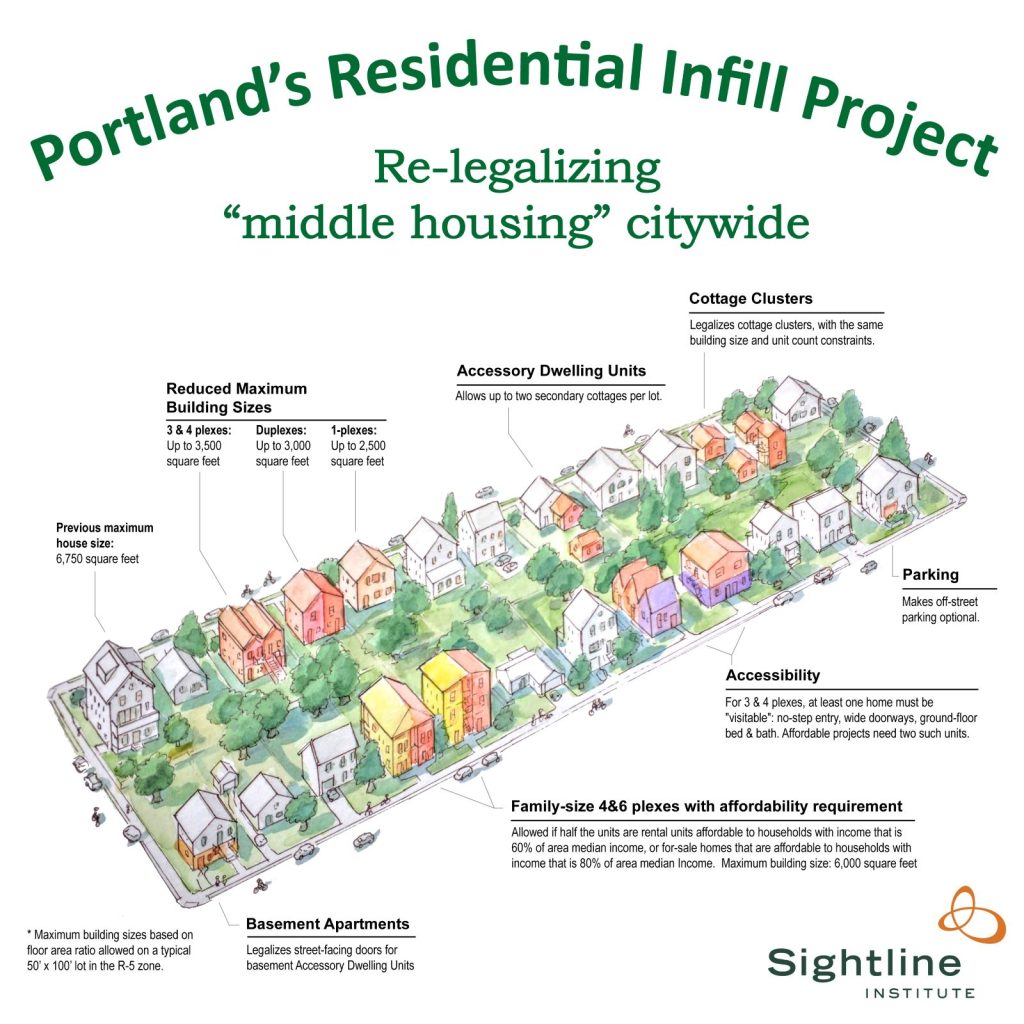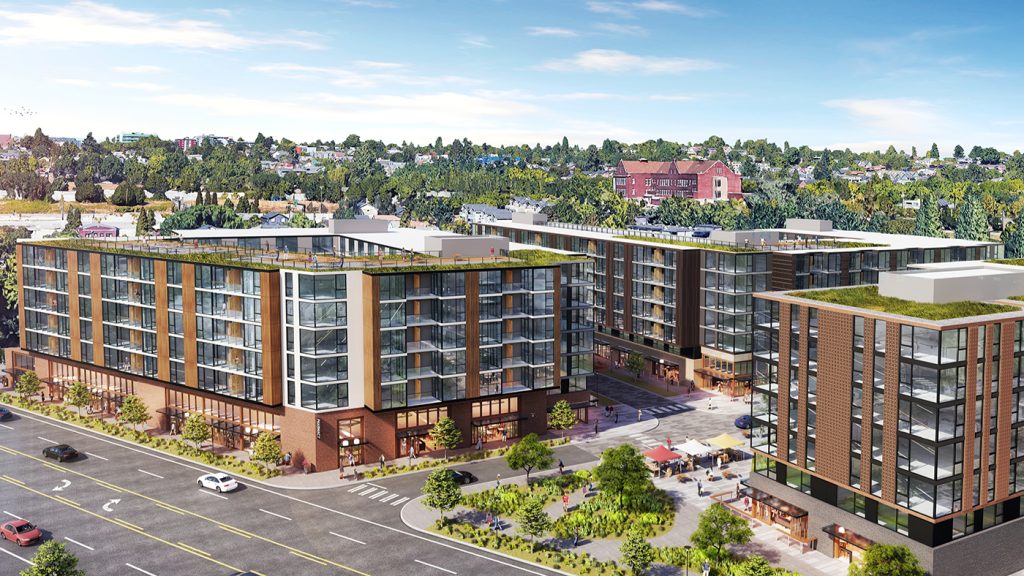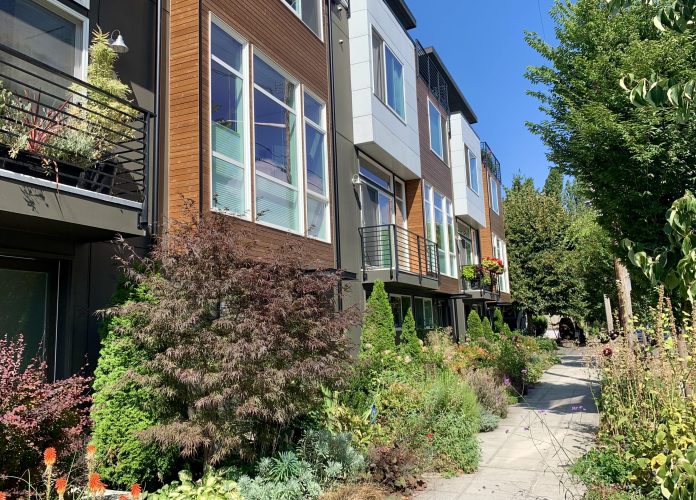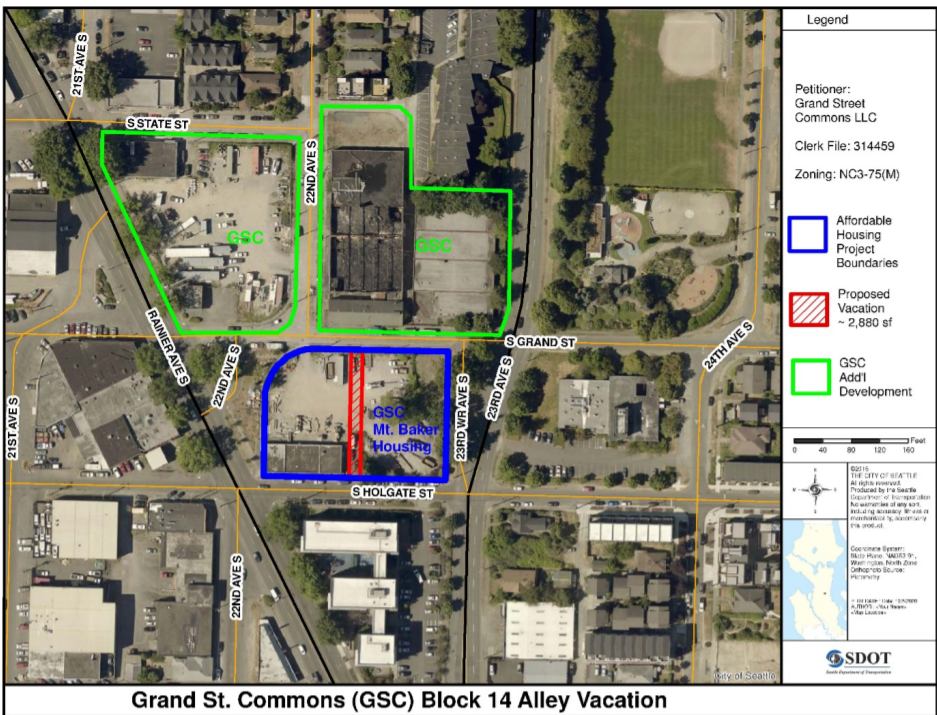The Seattle City Council took the first step toward reforming single-family zoning on Monday by renaming it “Neighborhood Residential” in a unanimous vote. In an action-packed agenda, the Council decriminalized entheogens (also known as plant-based psychedelics or magic mushrooms), passed a land use change in Interbay that will clear the way for the Seattle Storm WNBA team to build a practice facility there, set the public hearing for a North Rainier alley vacation for Grand Street Commons development, and expanded a transfer of development rights program to include Snohomish and Pierce counties.
Neighborhood Residential: A skirmish before a rezoning battle?
Councilmember Teresa Mosqueda (Position 8, Citywide) led the charge on the Neighborhood Residential name change, and she stressed that accuracy was part of the motivation.
“The legislation passed today brings us one step closer to a more inclusive Seattle,” Mosqueda said in a statement. “Today, we recognize neighborhoods across our city are home to diverse housing built before increasingly restrictive zoning went into place. This includes small businesses, parks, schools, and services, as well as diverse households that expand beyond the ‘single-family’ designation – that was a misnomer. ‘Neighborhood Residential’ reflects that diversity more accurately.”
Councilmember Strauss, who chairs the Land Use Committee and co-sponsored the bill, agreed and underscored that this move doesn’t change zoning. “This name change more accurately identifies existing zoning, as some of the most vibrant places in ‘single family’ zones have legacy duplexes, triplexes, and corner-stores, all of which are not currently allowed,” he said in a statement. “This proposal is in response to the Seattle Planning Commission’s Neighborhoods for All report which recommended this name change. This legislation does not change zoning, it only changes the name that we call these areas.”
The Neighborhoods For All report came out in 2018. Seattle Planning Commission, echoing other housing advocates, urged the city to re-legalize duplexes, triplexes, fourplexes, and corner-stores that had previously been allowed throughout the city.
Jazmine Smith recapped this history of exclusion in a column in The Urbanist: “When Seattle first established zoning ordinances in 1923 through the Comprehensive Plan, people had previously been able to reside in multifamily housing anywhere housing was permitted. After the introduction of the Comprehensive Plan, influenced by racist planner Harland Bartholomew, Seattle began to be downzoned with the introduction of single-family zoning and with that name and zoning change, dense and diverse housing options were relics of the past in areas focused on building neighborhoods of wealthier, White homeowners. The 1947 Comprehensive Plan downzoned swaths of multifamily housing to duplexes.”
The Seattle City Council did liberalize rules for backyard cottages and basement flats in 2019, which allows many single-family lots to fit three homes, but two would have to be accessory and capped at 1,000 square feet. Many housing advocates want the city to go further.

“A neighborhood is so much more than a single type of building — it’s a place people live and love and work and call home. This simple change reflects both the current reality of the way many Seattleites live and our vision of Seattle as a city rich with homes for all shapes and sizes of families,” said Brittney Bush Bollay, Chair, Sierra Club Seattle Group.
To move forward with even the renaming took extensive public outreach, as the Mosqueda press release summarized. “This legislation was accompanied by extensive public outreach, including two public hearings; four conversations in Council committees; a Community Housing Roundtable that included organizations working to reverse displacement and build affordable housing; meetings with myriad organizations focusing on housing, equity, the environment and community-driven development; a community letter that was sent to nearly 400 individuals and organizations who are connected with the 17 neighborhoods whose neighborhood plans currently reference the term single-family; as well as an open call to community organizations that were interested in a briefing on the proposal.”
Mosqueda said the feedback was predominantly positive. While some public commenters at the start of the Council meeting worried about the loss of “neighborhood character” and moving too fast, Mosquda opined “the true character of Seattle neighborhoods” was “diverse housing, small businesses, and many different types of households.”
In her piece, Smith explained why the name change is important — not merely a symbolic gesture: “[By renaming] areas that are deemed ‘Single Family’ as ‘Neighborhood Residential,’ we stop erasing our neighbors who are renters, we stop erasing the big and beautiful non-detached housing that was once the norm, and we normalize the missing middle housing models for lovely, walkable neighborhoods,” she wrote. “We also start to turn our back on the tools that were used for racist, exclusionary zoning that continue to impact today’s housing market. People like me used to be redlined out of Queen Anne, and now I will never be able to afford to buy a detached house in the neighborhood on an educator’s paycheck (or in the city in general). The language of zoning matters because it reiterates that the whole neighborhood is for me to reside, not just a node, or a hub, or a village.”
The name change legislation goes into effect on November 13th.
Seattle’s Comprehensive Plan is due for a Major Update in 2024 and housing advocates are looking to queue up further changes. In her comments before the vote, Council President Lorena González said she hoped the Council would follow up with zoning changes. González is running for Seattle Mayor on a platform that emphasizes ending exclusionary zoning, which helped earn her The Urbanist Elections Committee’s endorsement.
“It’s my hope that our zoning will also move forward in the near future to reflect the reality of our city’s rapid growth in the last decade,” González said. “I look forward to supporting the Council’s work in allowing more neighbors and the density that will be necessary to invite those families into all of our neighborhoods.”
Seattle Storm’s Interbay practice facility gets greenlight
In another unanimous vote, the Council passed an ordinance that increases size limit for a practice facility in Interbay’s industrial zone to 50,000 square feet. The Seattle Storm lobbied hard for the change and are the obvious beneficiary; they own the only suitable site for such a building and have long requested the change. With the new ordinance clearing the way, the Storm are likely to construct a practice facility in Interbay across from their headquarters building at 1616 W Bertona Street.
The 51,000 square foot fenced lot is being operated as a vehicle storage facility, which led several Councilmember Andrew Lewis (District 7) to suggest a practice facility there would be an urbanist win, providing more active uses and “eyes on the street,” evoking Jane Jacobs. Councilmembers expressed hopes that the practice facility would be open to the public, like the Kraken hockey practice facility in Northgate. However, public access wasn’t stipulated in the ordinance.
Our reporter Ray Dubicki has covered the City’s mess of conflicting or misguided policies in Interbay and wrote that the Storm practice facility was another example of loading up the land use code with elaborate carveouts rather than committing to reforms to simplify it, truly promote industrial vibrancy, and clear the way for dense housing in more parts of the city.
Likewise, Publicola‘s Erica Barnett framed the move as counter to the spirit of the industrial land use reform it is about to enact and rushed in waning months of the Durkan administration as a favor to a friend and political ally — Storm owner Ginny Gilder was a Durkan donor. Meanwhile, SCC Insight‘s Kevin Schofield contended the ordinance was an illegal spot rezone peddled with lies, but admitted it’s unlikely to face a challenge due to few people having standing and the potential for public relations blowback. Councilmembers disagreed with that assessment and some seemed to bristle at the accusations; Councilmember Andrew Lewis referred to Schofield as an armchair land use attorney.
Council decriminalizes Magic Mushrooms
The Council unanimously passed a resolution decriminalizing entheogens (such as magic mushrooms, the common term for psilocybin), responding to a campaign from Decriminalize Nature Seattle. Resolution sponsor Andrew Lewis noted entheogens are used indigenous rituals and have found increasing medical acceptance, with some offering them as a leading treatment for some forms of depression and anxiety. Sarah Stuteville wrote about her own experience using psilocybin as a mental health treatment in a South Seattle Emerald op-ed.
The resolution decriminalized plant-based entheogens, which means LSD and other synthetic psychedelics won’t be decriminalized by this resolution. Additionally, Lewis said that he opted to remove peyote from the resolution based on guidance from Decriminalize Nature.
In her comments, Councilmember Kshama Sawant did offer that the Council should use an ordinance rather than a resolution so their policy direction would be binding, worrying the Seattle Police Department (SPD) may not follow their guidance. She also complained her competing bill had languished.
The resolution does include the promise of further legislation. It “states the Council’s intent, at a later date, to advance legislation that revises the Seattle Municipal Code (SMC) to (1) establish entheogen-related offenses among the City’s
lowest enforcement priorities and (2) provide protections from arrest or prosecution for entheogen users, for those who cultivate entheogens for use in one or more of the contexts listed here, and for those who share entheogens with others in one or more of those contexts without financial consideration.”
Moreover, the resolution noted that the 2020 State v. Blake decision means that simple possession of drugs like entheogens “were no longer a sufficient basis for SPD to detain or arrest an individual” and that SPD had issued a directive to that effect. The Blake decision does not bar police departments from arresting individuals for intent to distribute entheogens and other illegal drugs.
Grand Street Commons alley vacation public hearing set
Another resolution sponsored by Councilmember Alex Pedersen and passed unanimously set the date for a public hearing for a alley vacation proposed in North Rainier for November 8th. The vacation will allow a 202-unit Mt. Baker Housing social housing project to proceed as part of the three-block Grand Street Commons development, which will add 771 units in all. Councilmember Mosqueda said the affordable housing the project will provide would more than meet the public benefit requirement for vacating public rights-of-way to developers.

The 3.2 acre development site is a brownfield that will be environmentally remediated as part of the development. Together, the 771-home complex is the largest project in a big building spree in North Rainier ahead of Judkins Park Station opening as part of East Link in 2023.
The alley doesn’t appear to be usable currently since the site is fenced in. Assuming no snags emerge ahead of or at the public hearing, the Council seems likely to approve the alley vacation to clear the way for the social housing project.
Council approves transfer of development rights program
Finally, the Council approved an ordinance that allow the city’s transfer of development (TDR) program to accept transfer from Pierce and Snohomish counties. Councilmember Strauss, who sponsored the bill, said it would help protect farm and forest lands in the suburban fringe while promoting density in Seattle’s downtown core — which is the only area TDR programs can send development rights for added height and density. The program already applies to King County agricultural and forest lands.
Doug Trumm is publisher of The Urbanist. An Urbanist writer since 2015, he dreams of pedestrian streets, bus lanes, and a mass-timber building spree to end our housing crisis. He graduated from the Evans School of Public Policy and Governance at the University of Washington in 2019. He lives in Seattle's Fremont neighborhood and loves to explore the city by foot and by bike.



